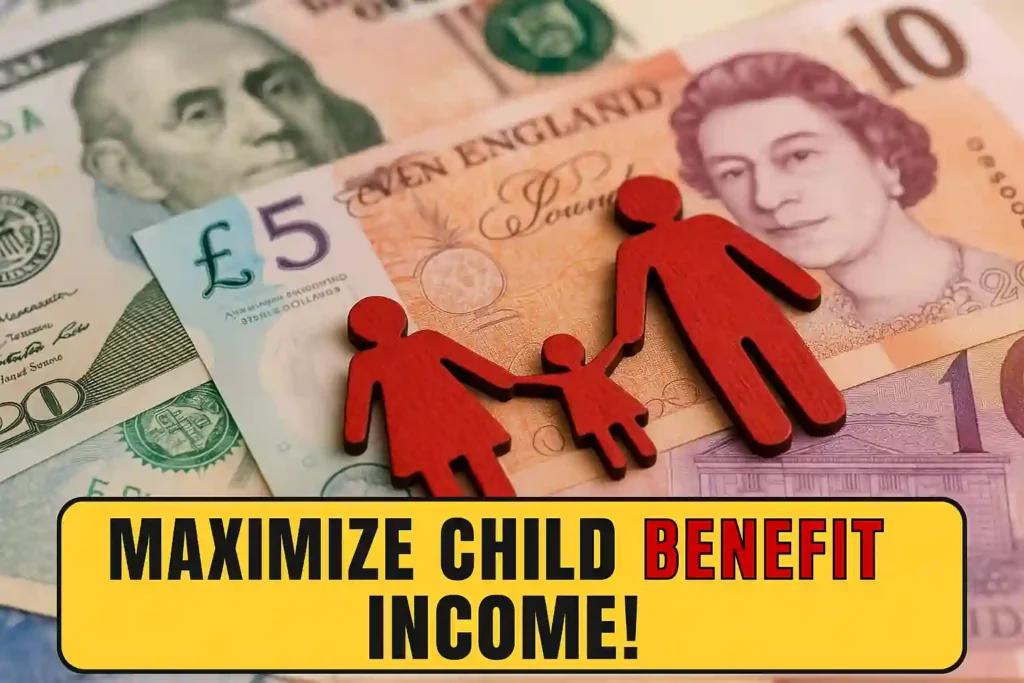Child Benefit 2025: The UK government has introduced significant changes to the Child Benefit system in 2025, targeting families earning up to £80,000 annually. This guide outlines the key reforms, strategies to reduce the High Income Child Benefit Charge (HICBC), and ways to maximize your entitlements effectively.

2025 Child Benefit Income Thresholds and Changes
| Income Range | HICBC Reduction Rate | Impact on Child Benefit |
|---|---|---|
| Up to £60,000 | No Charge | Full Benefit Retained |
| £60,001 – £80,000 | 1% per £100 above £60k | Partial Benefit Reduction |
| Over £80,000 | Full Charge | Entire Benefit Clawed Back |
Understanding the High Income Child Benefit Charge (HICBC)
The HICBC is a tax charge applied to individuals whose income exceeds £60,000 and who receive Child Benefit. For every £100 of income over the £60,000 threshold, 1% of the Child Benefit must be repaid.
Example: Income of £70,000 results in a 10% repayment of the Child Benefit. Income of £80,000 results in a full repayment of the Child Benefit.
How to Calculate Adjusted Net Income for HICBC
Adjusted net income includes your total taxable income before personal allowances, minus specific tax reliefs. This includes:
- Pension contributions
- Gift Aid donations
- Trading losses
HMRC provides an online calculator to help families determine their HICBC liability accurately.
Strategies to Reduce HICBC Liability
- Increase Pension Contributions:
Boosting pension contributions can reduce taxable income. Example: A 40-year-old earning £75,000 increases monthly pension contributions from £200 to £600. This strategy can retain £1,913 annually in Child Benefit and increase retirement savings. - Gift Aid Donations:
Donating to registered charities under the Gift Aid scheme can reduce adjusted net income, minimizing the HICBC impact. - Salary Sacrifice Schemes:
Consider salary sacrifice arrangements for benefits such as childcare vouchers or cycle-to-work schemes, which lower taxable income.
Why Claim Child Benefit Even With a High Income?
Even if your income exceeds £80,000, it is advisable to claim Child Benefit and opt out of payments to:
- Ensure automatic National Insurance number issuance for your child at age 16.
- Accrue National Insurance credits that count towards the State Pension.
Failure to claim can lead to missed entitlements and administrative complications.
Upcoming Changes: Household-Based Assessment in 2026
Currently, the HICBC is assessed based on individual income, which can disadvantage single-income households. The government plans to implement a household-based assessment by April 2026, aiming for a more equitable system.
Conclusion
The 2025 Child Benefit reforms provide increased support to middle-income families by raising the HICBC threshold to £60,000 and phasing out benefits only at £80,000. With effective tax planning, such as increased pension contributions and salary sacrifice schemes, many high earners can still retain some or all of their Child Benefit entitlements.
FAQs About Child Benefit 2025
1. What is the new Child Benefit income threshold in 2025?
The income threshold for the High Income Child Benefit Charge (HICBC) has been raised to £60,000, with the full clawback occurring at £80,000.
2. Will I lose my Child Benefit if I earn over £80,000?
Yes, if your income exceeds £80,000, the entire Child Benefit amount will be clawed back through the HICBC.
3. Can both parents earn £60,000 and still receive full Child Benefit?
Yes, as the HICBC is based on individual income, both parents can earn up to £60,000 each and still retain full Child Benefit.
4. How can I reduce my HICBC tax charge?
Increase pension contributions, make Gift Aid donations, or engage in salary sacrifice schemes to lower your adjusted net income.
5. Should I still claim Child Benefit if I earn over £80,000?
Yes, claim the benefit but opt out of payments to retain National Insurance credits and ensure your child receives their National Insurance number at age 16.
6. How much Child Benefit can I claim in 2025?
The amount depends on the number of children and your adjusted net income. Use the HMRC calculator for an accurate estimate.
7. What is “adjusted net income” for Child Benefit 2025?
It is your total taxable income before personal allowances, minus specific tax reliefs such as pension contributions and Gift Aid donations.
8. When will Child Benefit move to household-based assessment?
The transition to a household-based assessment is planned for April 2026.
9. Does paying into a pension help me keep my Child Benefit?
Yes, pension contributions reduce your taxable income, which can help lower or eliminate your HICBC liability.
10. How do I stop or restart Child Benefit payments?
You can manage your Child Benefit payments through the HMRC online portal or by contacting the Child Benefit Office directly.